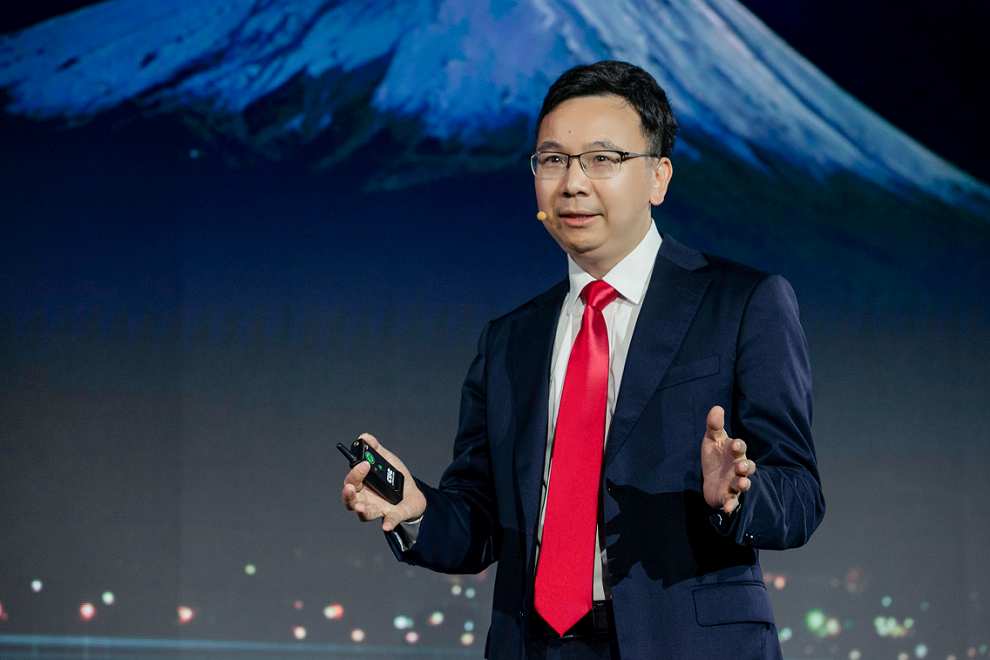At Global Mobile Broadband Forum, company also reveals new green, low-carbon solutions to power future 5G networks in the Middle East and beyond
With changes in user behavior and industry digitization posing higher requirements on 5G networks, Huawei has outlined strategies for how to build ubiquitous gigabit networks and a “5Gigaverse society” during the 12th Global Mobile Broadband Forum (MBBF) 2021.
Yang Chaobin, President of Huawei Wireless Solution, delivered a keynote speech at the forum, noting: “5G is developing rapidly worldwide, with more than 170 networks built and nearly 500 million users developed within two years. As 5G commercial deployment enters a new phase, users need more continuous experience, and industry digitalization poses new requirements on 5G capabilities. Therefore, we believe that the next step is to evolve 5G from hotspot to all-scenario continuous coverage, from Gbps to 5Gigaverse, and from pilot industry to all-industry digitalization, to build a ubiquitous gigabit network and a 5Gigaverse society.”
It is expected that by 2030, mobile networks will carry more traffic than wired networks and become the main bearer of internet traffic. Meanwhile, progress has been made in industry digitalization. 5G has enabled more than 10,000 scenarios in more than 20 industries worldwide. In the future, 5G capabilities will continue to evolve to incorporate fragmented connections in various industries, creating an IoT space with hundreds of billions of connections.
“Innovation will never stop,” adds Chaobin. “The next decade will be a decade of 5G. 5G will continue to evolve and innovate toward 5.5G. We hope to work with global partners to continuously innovate based on user experience and industry requirements to take user experience to new heights while digitally transforming industries.”
Massive MIMO and ultra-wideband
Two years of commercial 5G deployment has proved that the Massive MIMO and ultra-wideband technologies can improve user experience by 10 times and have become the choice of most operators around the world.
It has become an industry consensus that Massive MIMO is the right choice for deployment with continuous large-bandwidth TDD bands. For markets with discrete spectrum, Huawei launched Massive MIMO AAU with 400 MHz bandwidth to enable simplified deployment. For markets with limited antenna spaces, Huawei now offers BladeAAU that supports simplified single-antenna deployment through the integration of sub-3 GHz and Massive MIMO. Huawei also released the new 64TRX MetaAAU with improved performance and energy saving.
Huawei’s brand-new MetaAAU introduces the extreme-large antenna array (ELAA) technology and the innovative AHR Turbo solution, marking a new breakthrough in Massive MIMO coverage and energy efficiency.
For markets where new TDD bands are not licensed yet, the legacy FDD spectrum can be used to modernize installed bases using the Massive MIMO and ultra-wideband technologies, reducing deployment costs and improving 4G and 5G experience and capacity.
Huawei’s high-power, ultra-wideband 4T4R RRU supports three bands in one box, simplifying multi-band network deployment. It enables full-band and all-RAT dynamic power sharing, improving user experience by 30% and reducing power consumption by 30%.
Huawei also highlighted how pole sites extend macro coverage with on-demand simplified deployment for coverage hole fill-up and at hotspots. This is important for mobile networks in streets and residential areas where site acquisition is challenging, as they offer a simple approach to deploy macro sites by leveraging lamp poles and walls. In 2020, Huawei launched a series of simplified solutions to help operators quickly fill up 5G coverage holes. This year, Huawei released a new pole site product EasyBlink 2.0 to further simplify pole site deployment.
In addition, Huawei provides the industry’s only distributed Massive MIMO solution for 5G indoor ubiquitous Gbps experience. In indoor areas, simplified deployment is crucial for operators to implement multi-RAT and multi-band deployment that can ensure optimal user experience. Huawei’s LampSite solution supports TDD and FDD bands of multiple radio access technologies in one box and supports indoor distributed Massive MIMO. These features enable it to improve network capacity fourfold compared with 4T4R, ensuring indoor ubiquitous Gbps experience. It is the best suited to provide coverage in major indoor areas, such as airports, railway stations, and shopping malls.
A simplified 5GtoB solution for different campus scenarios
In factories and campuses, custom coverage is often required on the macro networks that are used to ensure continuous coverage. LampSite and EasyMacro provide an ideal choice for operators to quickly implement 5G coverage in indoor and outdoor campus areas, respectively. The SUL solution further enables operators to provide Gigabit uplink data speed. Huawei’s 5GtoB solutions enables operators to conveniently meet the differentiated requirements of different industries in uplink ultra-wideband, high-precision positioning, low latency, and high reliability.
In this decade, multi-band and multi-standard co-existence will be a major trend. Operators must coordinate macro, pole, and indoor 3D network O&M, meet differentiated experience of toB, toC, and toH users, and maximize network performance with minimized power consumption. This further highlights the urgency of developing intelligent wireless networks.
Low-carbon 5G networks
With this in mind, Aaron Jiang, President of Huawei’s SRAN Product Line, launched the GreenSite and PowerStar2.0 solutions to help operators build green, low-carbon 5G networks. The GreenSite solution integrates innovative architecture, site construction, and algorithms with leading-edge software and hardware, improving energy efficiency by 20 times. The PowerStar2.0 solution introduces new intelligent energy-saving features to base stations and networks to reduce energy consumption by over 25% through multi-dimensional coordination under typical configurations.












